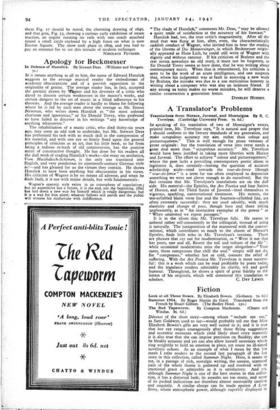London Life
The Streets of London Through the Centuries. By Thomas Burke. (Batsford. los. 6d.)
Jr you expect a book on the streets of London to tell you some- thing about the streets built up by Dr. Barbon, the great speculative builder of the seventeenth century, about the genesis and specific character of London's squares as against those on the Continent, about the cutting through of Long Acre in the early seventeenth, Queen Street and King Street in the City in the later seventeenth, Regent Street in the early nineteenth, Holborn Viaduct in the later nineteenth and Kingsway in the early twentieth centuries, or about the first by-pass road of London, the New Road (Marylebone and Euston Roads), you will be disappointed in Mr. Burke's new book which on all these and similar things contains nothing or near to nothing. What it provides is an entertaining and skilfully handled sketch of London life through the centuries, very varied and many-sided, though rather excessively dwelling on " Sittengeschichte "—the dirtier aspects of London slang and piquant or unsavoury details of London night-life of the past.
The best parts of the book seem to me the chapters on the Middle Ages and the last 150 years. For the late nineteenth and early twentieth centuries, where Mr. Burke draws on his own early memories, he has an admirable collection of characteristic tit-bits: the milk girls still with their two cans hanging from a wooden yoke, poor people carrying their joints to the bakehouse to have them roasted, landaus and broughams, the first electric " spelling " advertisements, the first underground public con- veniences. . . . The mediaeval chapter is short, but manages to give a surprisingly suggestive picture of London sights, smells and noises, and much interesting data probably unknown to most of Mr. Burke's readers, e.g., the various uses of the nave of St. Paul's and of Westminster Hall, or specimens of mediaeval slang which are still going strong (Cove, cranky, gone west). The chapters on the seventeenth and eighteenth centuries are too short, considering their Crucial importance for the building and planning development of London. What an infinite number of interesting facts on Stuart and Georgian London is accumu- lated in any of the four best recent books on London : S. E. Rasmussen's London (1937), N. Brett-James's Growth of Stuart London (i935), Sir H. Llewellyn Smith's History of East London (1939), and T. F. Reddaway's Rebuilding of London after the Great Fire (1940). Even if one is quite aware of the fact that Mr. Burke is not aiming at anything scholarly, one is justified in asking for a little more data and a little more accuracy. "Scores of plans were submitted to the King" after the fire of i666? We know only of five, if I am not mistaken. Exact dates are rarely given, except for the nineteenth and twentieth centuries. As a rule we find only "about this time," "somewhat later," &c. Quotations are frequently without any indication of their sources (pages 7, It, 21, 39, 44, &c.). The same is true of the earlier ilustrations. Not a word that some of them have nothing at all to do with London (Fig. 5, for example, with the caption "Stalls at a holiday assembly, fifteenth century" comes, as the reader is not told, from the Flemish manuscript of jean le Tavernier's Conquites de Charlemagne). - The index, on the other hand, is carefully arranged, and the illustrations are well chosen (though, again, I must add, for a book on London life and not on the history of London streets). Some of them are scarcely known. Among
them Fig. 17 should be noted, the charming drawing of 1640, and that gem, Fig. 53, showing a curious early exhibition of steam traction, an engine running on rails with one coach attached round a small circle enclosed by a high fence on what is now Euston Square. The show took place in 1809, and you had to pay an entrance fee to see this miracle of modern technique.
NIKOLAUS PEVSNER.































 Previous page
Previous page